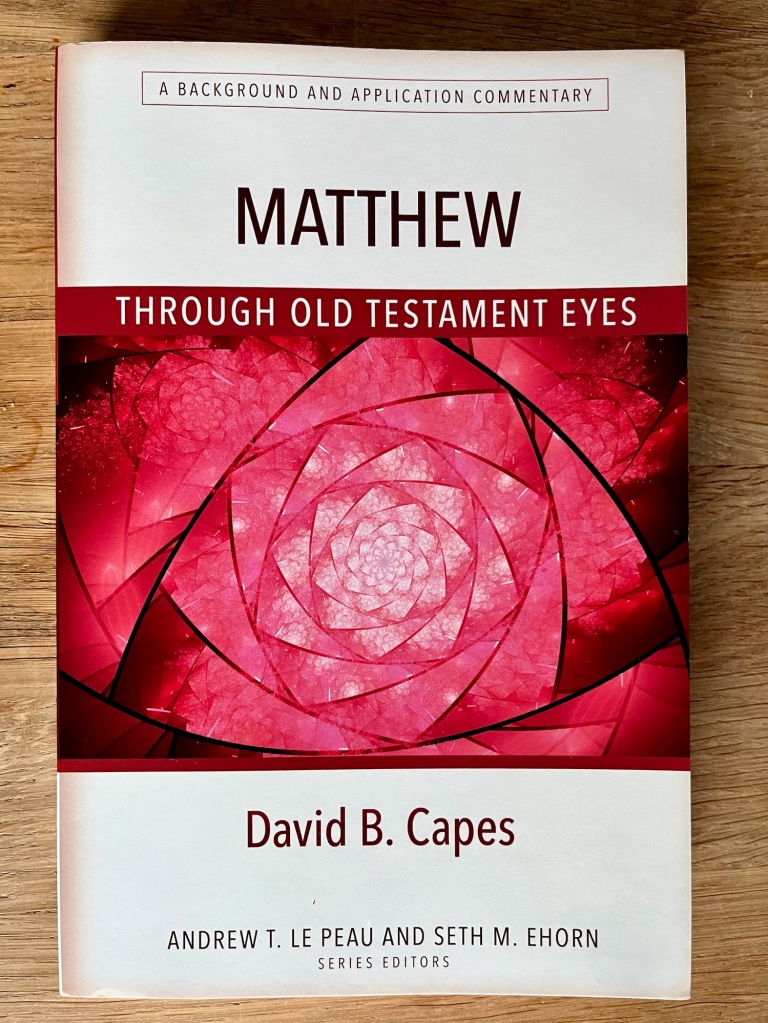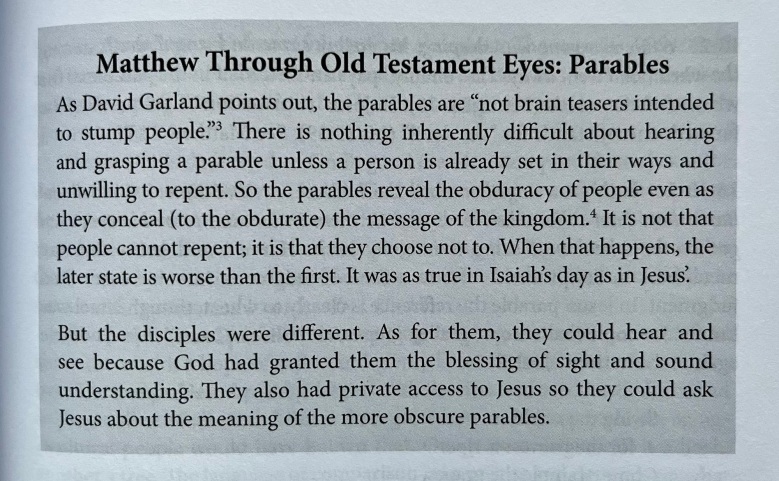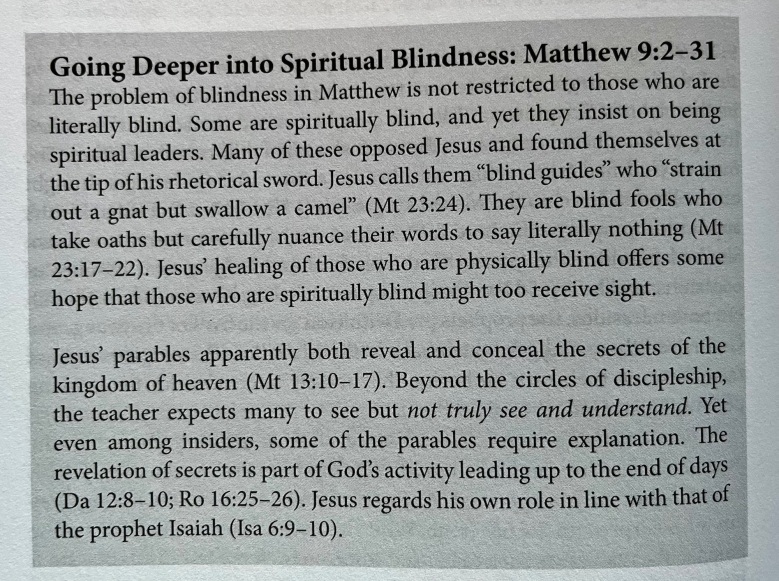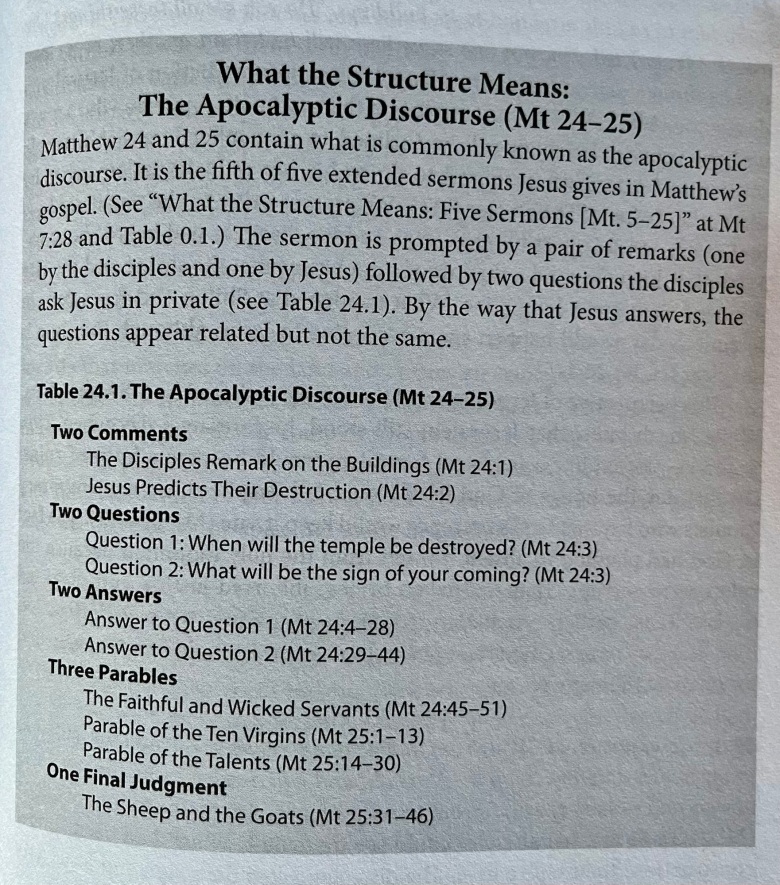David Capes—Executive Director of the Lanier Theological Library—has contributed a very insightful commentary on the Gospel of Matthew in Kregel Academic’s Through Old Testament Eyes series. His emphasis here is on how the OT informs Matthew’s Gospel so that we can understand Matthew’s meaning more clearly. Capes has written a book on Christ’s divinity (my review) and and introduction that helps us get to know Paul.
His work helps us get a handle on the larger structure of Matthew. One structuring device is Jesus’ five sermons:
- Matthew 5–7: The Sermon on the Mount;
- Matthew 10 Instructions to “the Twelve;”
- Matthew 13: The Parables of the kingdom;
- Matthew 18: Teachings on Discipleship;
- Matthew 24–25: The Destruction of the Temple and Lessons Regarding the End.
As well, an important framing device (an inclusio) revolves around Jesus as Immanuel, “God with us” (Matt 1:23), Jesus with the two or three who gather (18:20), and Jesus when he gives the great commission command backed up by the comfort that he “will be with you always” (28:20).
Authorship: Historians from this period did not usually attach their names to their works (such as Xenophon, Tacitus, and Plutarch). Just because Matthew’s Gospel lacks the author’s name within the text does not mean Matthew was anonymous. Did Matthew write this Gospel? We can’t know for sure, but Capes writes that “there is a strong tradition that links the apostle Matthew to the first gospel” (19).
Provenance: The city of Antioch in Syria “had a bustling Jewish community that spoke Greek and likely had access to the Hebrew Scriptures in Greek” (20). Capes points out that the mission to the gentiles was begun here (Acts 11:20; 13:1–3; Gal 2:11–12).
Date: Between AD 60–80.
Capes takes Matthew one chapter at a time according to the divisions we have in our Bibles today (so 28 chapters). He interprets each chapter usually verse-by-verse or by groups of two or three verses. He looks at how certain sections or verses are structured (with a list of all of these sections in the back of the book).
A Few Fascinating Mentions
- 3:16, “and he saw the Spirit of God descending like a dove…”
- In Psalm 74, the community of Israel begs God not to forget them. The enemy had defeated them and brought their temple down to the ground. In 74:19, they plead with God not to “hand over the life of your dove to the wild beasts.” Israel, God’s conquered people, are called “your dove” and “your afflicted people.” This image of a mourning, suffering people likened to a dove is seen in other prophetic texts (Isa 38:14; 59:11; Ezek 7:16). When the Holy Spirit descends like a dove upon Jesus, it “signals to Jesus his Spirit-directed role as a sufferer representing all of the Father’s people” (68).
- 3:17, “This is my Son, whom I love.”
- I was anticipating there to be a reference to Isaac in Gen 22:2, but Capes went in a different direction. First, “my son” picks up language from Psalm 2, particularly vv.6–7 (cf. 2 Sam 7:12–16). The one “whom I love” picks up language from Hosea 11:1, which has already come up in Matthew 2.
- 5:21–22, “the fire of hell.”
- Capes seems to take the view of annihilationism in these verses. Jesus’ words are linked with the final verse of Isaiah (66:24). Capes writes, “This is not an image of conscious suffering but one of utter destruction with no hope for life” (97).
- 7:22–23, “Then I will tell them plainly, ‘I never knew you. Away from me, you evildoers!'”
- These two verses began to bother me after reading a DesiringGod article a year or two ago. Could it be that a Christian could live a good and faithful life with its imperfections and hear these words after they die? Capes argues that 7:21–23 is a carry-over from Jesus’ warning against false prophets and teacher in 7:15–20. some who produce bad fruit will know Jesus’ name and will address him as “Lord,” but they do not know him.
- False prophets had always been a plague in Israel’s history (Deut 13:1–5; Jer 5:30–31; 6:14; 14:14–15; Mic 3:5–8), and they were in Jesus’ day as well. False shepherds were condemned harshly in the OT (Ezek 34). Jesus dismisses the false prophets in judgment, and takes his cue from Psalm 6:8.
- 8:11–12, “weeping and gnashing of teeth.”
- Here Capes draws a line back to Psalm 112, particularly v.10 and how the wicked will “waste away” (or “melt away,” as Capes writes). In regards to how this fits into a particular picture of hell, Capes goes no further. But in regards to its placement in Matthew, Capes points out that when Jesus healed the centurion’s servant it was disturbing for those “subjects of the kingdom” who believed they were okay. But it was “hopeful for Gentiles who come to Jesus in expectant faith” (135).
- 21:44, “Anyone who falls on this stone will be broken to pieces; anyone on whom it falls will be crushed.”
- The stone Jesus speaks of comes from Ps 118:22; Isaiah 8:13–15; 28:16; and Dan 2:44–45.
Recommended?
Capes has written a readable commentary for teachers and preachers that brings them back to the OT for understanding. Jesus, whose only Bible was the OT, was steeped in it. His language reflects the two-ways of Proverbs and Deuteronomy, the values of God on marriage beginning in Genesis 2, and reflects his knowledge of his divinity as he often associates himself with Yahweh. Capes’ commentary is full of OT insights that ought to teach you both more about the OT and more about Matthew. There are no major sections focused on application here, but Capes’ volume is an important one that will point you back to your Bible over and over again.
Lagniappe
- Author: David B. Capes
- Paperback: 389 pages
- Publisher: Kregel Academic (March 26, 2024)
Buy it from Amazon or Kregel Academic!
Disclosure: I received this book free from Kregel Academic. The opinions I have expressed are my own, and I was not required to write a positive review. I am disclosing this in accordance with the Federal Trade Commission’s 16 CFR, Part 255 http://www.access.gpo.gov/nara/cfr/waisidx_03/16cfr255_03.html.




